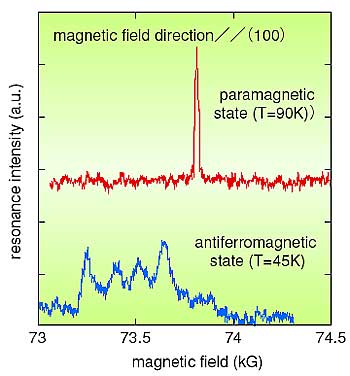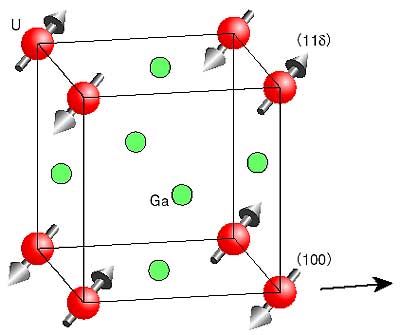The 5f electrons dominate the magnetism and electronic properties of uranium intermetallic compounds. It is noteworthy that the orbital degeneracy remains intact in 5f electron systems. In 3d electron systems, this orbital degeneracy is usually lost. The orbital moment is somewhat dependent on the spin moment through the spin-orbit interaction in 5f electron systems. For 5f electron systems, new electronic properties and ordered states resulting from the orbital degeneracy are found to occur. These effects have attracted a great deal of attention. Nuclear magnetic resonance (NMR) is one of the few methods by which we can study the magnetism and electronic properties of these systems microscopically. Since the static and dynamic magnetism can both be probed, this is a particularly effective method by which to investigate 5f magnetism. Here, in the compound UGa3, in which a heavy fermion state has appeared through electronic correlations among the 5f electrons, the orbital ordering which accompanies antiferromagnetic ordering has been observed directly for the first time by nuclear magnetic resonance. The 69Ga NMR spectrum (m=1/2 3/2 transition) under an external magnetic field along the (100) direction in the paramagnetic state is shown in Fig. 4-7. In this case only one sharp resonance line is observed. This shows that the magnetic field=(internal+external magnetic field) at the Ga site is uniform. This compound enters into a magnetically ordered state below 67K. Neutron scattering data show that this magnetically ordered state is a type II antiferromagnetic state with propagation vector Q=(1/2, 1/2, 1/2). The NMR spectrum in the ordered state has been recorded and found to be split into four peaks (Fig. 4-7). This splitting is a consequence of the ordered moments which occur at the U sites in the ordered state, giving rise to four different internal magnetic fields at the Ga sites. It might be expected that the internal magnetic field at the Ga site would vanish in the Type II state for the cubic structure of UGa3 (Fig. 3/2 transition) under an external magnetic field along the (100) direction in the paramagnetic state is shown in Fig. 4-7. In this case only one sharp resonance line is observed. This shows that the magnetic field=(internal+external magnetic field) at the Ga site is uniform. This compound enters into a magnetically ordered state below 67K. Neutron scattering data show that this magnetically ordered state is a type II antiferromagnetic state with propagation vector Q=(1/2, 1/2, 1/2). The NMR spectrum in the ordered state has been recorded and found to be split into four peaks (Fig. 4-7). This splitting is a consequence of the ordered moments which occur at the U sites in the ordered state, giving rise to four different internal magnetic fields at the Ga sites. It might be expected that the internal magnetic field at the Ga site would vanish in the Type II state for the cubic structure of UGa3 (Fig.
4-8). The internal magnetic fields found here show that the cancellation conditions have by some mechanism failed to occur. The internal magnetic field at the Ga sites is proportional to the hyperfine coupling constant between the U moments and the Ga nuclear spins. Since there are two U sublattices, with "up" and "down" ordered moments in the ordered state, the hyperfine coupling constants for these two sites are evidently not the same. As a result, the internal magnetic field no longer cancels out at the Ga site. We believe this breaking of symmetry to be a consequence of orbital ordering. This is the first observation of orbital ordering of 5f electrons obtained via the breakdown of hyperfine interaction symmetry. Moreover, since the resonance line is split into four peaks, the direction of the ordered moment is concluded to be [1,1,delta] from considerations of symmetry (1>delta>0). Since this orientation could not be obtained from neutron scattering results, it is determined for the first time by NMR. Thus, a variety of new features which we attribute to the 5f electrons in uranium compounds are emerging from NMR studies. |


 3/2 transition) under an external magnetic field along the (100) direction in the paramagnetic state is shown in Fig. 4-7. In this case only one sharp resonance line is observed. This shows that the magnetic field=(internal+external magnetic field) at the Ga site is uniform. This compound enters into a magnetically ordered state below 67K. Neutron scattering data show that this magnetically ordered state is a type II antiferromagnetic state with propagation vector Q=(1/2, 1/2, 1/2). The NMR spectrum in the ordered state has been recorded and found to be split into four peaks (Fig. 4-7). This splitting is a consequence of the ordered moments which occur at the U sites in the ordered state, giving rise to four different internal magnetic fields at the Ga sites. It might be expected that the internal magnetic field at the Ga site would vanish in the Type II state for the cubic structure of UGa3 (Fig.
3/2 transition) under an external magnetic field along the (100) direction in the paramagnetic state is shown in Fig. 4-7. In this case only one sharp resonance line is observed. This shows that the magnetic field=(internal+external magnetic field) at the Ga site is uniform. This compound enters into a magnetically ordered state below 67K. Neutron scattering data show that this magnetically ordered state is a type II antiferromagnetic state with propagation vector Q=(1/2, 1/2, 1/2). The NMR spectrum in the ordered state has been recorded and found to be split into four peaks (Fig. 4-7). This splitting is a consequence of the ordered moments which occur at the U sites in the ordered state, giving rise to four different internal magnetic fields at the Ga sites. It might be expected that the internal magnetic field at the Ga site would vanish in the Type II state for the cubic structure of UGa3 (Fig.